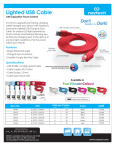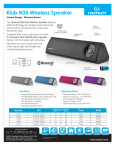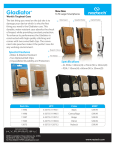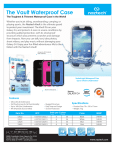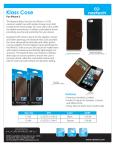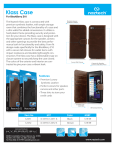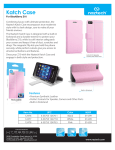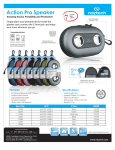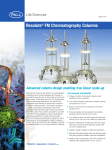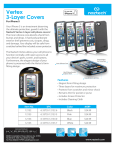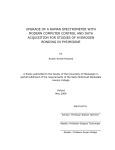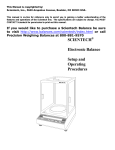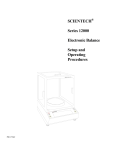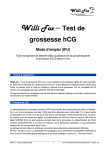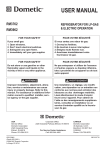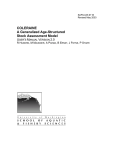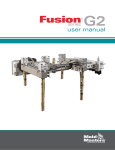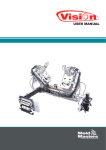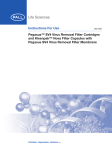Download HEA and PPA HyperCel™ Mixed-Mode
Transcript
HEA and PPA HyperCel™ Mixed-Mode Chromatography Sorbent USD 2464(a) Packing Protocol for Conventional Columns From 9 cm to 45 cm I.D. 1. Introduction HEA and PPA HyperCel sorbents are mixed mode scalable chromatography sorbents designed for protein capture and impurity removal. They are part of a family of mixed mode chromatography sorbents which provide new selectivities orthogonal to conventional chromatography steps. HEA and PPA HyperCel sorbents operate on the basis of a mixed-mode mechanism where both hydrophobic and ionic effects are predominant. The two different robust ligands, aromatic (based on phenylpropylamine – PPA) and aliphatic (based on hexylamine – HEA) offer different selectivity options according to the nature of the feedstock. The physical and mechanical properties of these two sorbents are well suited to both laboratory and process scale applications. Column packing is always a critical operation for ensuring good separation performance and consistency of results. Three main steps are required for packing operations and evaluation of packing efficiency: l Sorbent slurry preparation l Column packing l Packing performance evaluation 6. Plastic paddle or propeller. Do not use magnetic stirrers which may damage the beads. Optional: 7. Sorbent transfer pump: A membrane pump to fill the column with the sorbent slurry or to empty the column. To avoid damaging the beads, do not use a peristaltic pump. 8. Suction pump: This pump will eliminate supernatant during the sorbent slurry preparation prior to packing. Table 1 Volumetric Flow vs. Linear Flow Rate Column Diameter (cm) 9 10 14 18 20 30 45 Surface Area (cm2) 64 79 154 254 314 707 1,590 Flow Rate (L/hr) 100 cm/hr 300 cm/hr 6.4 19.1 7.9 23.6 15.4 46.2 25.4 76.3 31.4 94.2 70.7 212.0 159.0 476.9 600 cm/hr 38.2 47.1 92.3 152.6 188.4 423.9 953.8 2. Equipment and Sorbent 1. Appropriate volume of HyperCel sorbent (refer to Section 3 for the calculation of the required volume). HEA and PPA HyperCel sorbents are provided in drums for process-scale applications. Pack sizes of 1 L and more are under wet cake form, pack sizes below 1 L are under slurry form. The sorbent is supplied in a storage solution of 1 M NaCl containing 20% (v/v) ethanol. 2. Conventional pilot or large-scale column of a diameter ranging from 9 to 45 cm. 3. Chromatography system and pumping capabilities. For packing operations, the pumping system should be able to operate at 600 cm/hr. Refer to Table 1 for the appropriate volumetric flow rates according to the column diameter. 4. The appropriate volume of packing buffer. Usually 15 column bed volumes are necessary. For both sorbents, phosphate buffer saline (PBS) ensures good packing performance (for alternative packing buffer, contact Pall Technical Service). 5. Transparent slurry tank: l of a volume 4 to 5 times that of the chromatography sorbent. l transparent to allow the user to see the sorbent bed throughout the process. 2 3. Calculation of Required Volume of Sorbent HEA and PPA HyperCel sorbents are semi-rigid and have to be packed compressed to provide best packing performances and packed bed stability. It is important to anticipate the compression factor (CF) shown in Table 2, depending on the diameter of the column. CF = Volume of gravity-settled sorbent Volume of packed sorbent Because the volume of gravity-settled sorbent depends on the nature of the buffer, volumes are measured once the sorbent is equilibrated in packing buffer. Example: 10 L of gravity-settled sorbent equilibrated in the packing buffer, once packed in a 14 cm diameter column, will be approximately equivalent to 8 L (CF = 1.25). Table 2 Recommended Compression Factors for HEA and PPA HyperCel Sorbents Column Diameter (cm) 9 and 10 14 18 20 Compression Factor (CF) 1.15 – 1.20 1.25 – 1.30 1.30 – 1.35 1.35 – 1.40 30 to 45 ³ 1.40 4. Sorbent Slurry Preparation 5. Sorbent Slurry Concentration Determination Allow the sorbent and the packing buffer to equilibrate at room temperature, best overnight to avoid degassing issues. During packing, it is important to know the volume of sorbent that has been added into the column. The slurry concentration determination is a critical step in this process. l l If the sorbent is in slurry form, make sure that it is fully settled, then remove the storage solution from the settled sorbent in the storage drum. Then proceed as described in the procedure below. If the sorbent is in moist cake form, proceed directly as follows: The method for slurry concentration determination is the following: 1. Fully resuspend the slurry previously equilibrated in the packing solution. Collect 4 samples of 10 mL slurry in graduated tubes. 1. Add packing buffer in the storage drum. Fully resuspend the sorbent by rolling the drum (fasten the lid securely) or, if this is not possible, by creating a vortex using a plastic paddle. Transfer this slurry in the slurry tank manually or using a membrane pump. Rinse the drum with packing buffer until the beads are totally collected. 2. Centrifuge the tubes between 20-g and 200-g for 1 to 5 minutes. 2. Allow the slurry to settle completely and remove the supernatant, manually or using a suction pump. 5. Repeat steps 2 to 4, until the bed height is stable. Then the concentration of slurry is evaluated as Sorbent volume / Total volume and expressed as a percentage. 3. Add 3 volumes of packing buffer and carefully resuspend the sorbent using gentle agitation (i.e., by creating a vortex) using a plastic paddle (no stainless steel) to obtain a fully homogeneous slurry. 4. Allow the slurry to settle completely and remove the supernatant, manually or using a suction pump. 5. Repeat steps 3 to 4 twice (i.e., 3 times in total). 6. Resuspend the sorbent by gentle agitation for 3 to 5 minutes. To ascertain that the sorbent is properly equilibrated, check the pH (slurry pH ~ packing buffer pH). The slurry is now ready for packing. Example of calculation to prepare a 65% (v/v) slurry. For a volume of 3 L of sorbent, the amount of packing buffer required to obtain a 65% slurry should be calculated as follows: l Total volume of a 65% slurry = Volume of sorbent 0.65 3 = = 4.6 L 0.65 l 3. Mark the level of settled sorbent on each tube. 4. Gently tap the tubes to allow rearrangement of the beads (care should be taken not to resuspend the slurry). Example to calculate the volume of slurry necessary for packing. For a 70% slurry, the amount of slurry required to pack a column of 14 cm I.D. x 20 cm bed height (BH) with a compression factor (CF) of 1.25 should be calculated as follows: π x column radius² x BH = 3.1 L l Column volume (CV) = 1000 l Volume of sorbent to be transferred = CV x CF = 3.9 L l Volume of slurry to be transferred 3.9 = 5.5 L 70% (= 35.7 cm height) = Volume of packing buffer = Total volume – sorbent volume = 4.6 – 3 = 1.6 L www.pall.com/biopharm 3 6. Column Packing Optional: It is critical to pack a homogeneous slurry. Before applying the flow rate, fully resuspend the slurry. 7. Although it is not critical to the chromatography process, a blank run including the CIP is recommended to ensure the robustness and the stability of the packed bed: 1. Introduce a thin layer (0.5 to 1 cm) of packing solution into the column. Remove any air bubbles that may be trapped behind the frits at the bottom plate or top piston. 2. Transfer the slurry into the column, manually or using a membrane pump. When all the slurry is transferred into the column, gently stir the slurry within the column tube using a plastic paddle to ensure that the slurry is fully dispersed and homogeneous. Stop agitation (break the created vortex) and remove the paddle. Wait several minutes (usually 1 to 2 minutes) until a band of clear supernatant (approximately 1 to 2 cm deep) appears above the slurry. 3. As rapidly as possible, introduce carefully the upper piston into the column, positioned in the region of clear packing solution above the slurry. Avoid introduction of air (or remove it). Do not disturb the sorbent as it settles. Seal the piston against the column tube as rapidly as possible 4. As soon as a seal is established, initiate pumped flow of the packing solution. Operate at a linear velocity of 600 cm/hr. Pressure drop must be maintained under 3 barg. Continue pumped flow until the bed is fully consolidated and no further compaction of the bed is observed. At this point, carefully note and mark the position of the bed height. 5. Stop the pump and drop the piston 10 mm above the packed bed. Pumped flow at a linear velocity of 600 cm/hr until the bed is fully consolidated and no further compaction of the bed is observed. 6. Stop the pump, adjust the piston by positioning the net and frit so that it touches the sorbent bed. Open the column outlet and start the pump at the same packing flow rate (i.e., 600 cm/hr). If further settling of the bed occurs, adjust the piston again. Maintain the flow rate (i.e., 600 cm/hr) for 5 to 10 minutes to ascertain consolidation of the sorbent bed. A clear headspace may appear at the top of the bed. In this case, repeat the previous steps as many times as necessary until the bed is stable under flow and there is no headspace visible beneath the piston. 1 hour with 1 M NaOH at a linear flow rate of 100 cm/hr. After the first cleaning, a headspace may be visible on the top of the sorbent bed. In this case, it is important to eliminate it by re-adjusting the upper piston down until it touches the bed. 7. Packing Performance Measurement The column must be fully equilibrated with the HETP running buffer (e.g., PBS or 20 mM sodium phosphate, 0.5 M NaCl, pH 7.0) prior to HETP determination. Two options for HETP injection: 7.1. 5% (v/v) acetone Inject a pulse of 5% (v/v) acetone in the equilibration buffer, corresponding to 1% of the column bed volume at a linear velocity of 100 cm/h. Record UV traces at the column outlet. Determine the number of plates per meter (N/m) and the asymmetry factor (AF). 7.2. 2 M NaCl Inject a pulse of 2 M NaCl in the equilibration buffer, corresponding to 1% of the column bed volume at a linear velocity of 100 cm/h. Record conductivity traces at the column outlet. Determine the number of plates per meter and the asymmetry factor. To ascertain that there is no interaction between NaCl and the packed sorbent, it is recommended to use a background buffer with 0.5 M NaCl. To determine the packing performance, use the following formulas: 2 N/m = 5.54 x 100 x (Ve / W½) BH With: N Ve W½ BH = = = = Number of theoretical plates Elution volume on the chromatogram (cm) Width of the peak at half-height (cm) Bed height (cm) AF = b a With: b = Right section of the peak at 10% peak height a = Left section 4 Absorbance / Conductivity Figure 1 Peak Trace in a Typical Test Evaluation of Column Performance 8. Pressure Performance The volumetric flow rate for columns of the same length will increase with the diameter, when the linear flow rate is maintained constant. Pressure drop will differ when the buffer composition changes. Typically, backpressure may increase in acidic pH buffer conditions. W½ 10 0 % 50% b 10% Volume / Time Packing performance may vary after the first CIP performed on a packed bed. We recommend to use the performance measured after the first CIP as reference. Backpressure (barg) a Figure 2 Typical pressure vs. flow curve for HEA and PPA HyperCel sorbent in PBS buffer 2.0 HEA HyperCel 1.5 1.0 PPA HyperCel 0.5 0 The typical values for the number of plates per meter range between 1,500 and 3,000 m-1. Theses values are given as the average of experimental values at 100 cm/hr. More important than the values itself, the reproducibility of the values over the process and over the successive packing operations is critical. The asymmetry factor must range between 0.8 and 1.8 for a good packing. Values < 0.8 (peak fronting) indicate an overpacked column, and values >1.8 (peak tailing) indicate an underpacked column or channeling: in this case, the sorbent will have to be repacked 0 100 200 300 400 500 Linear flow rate (cm/hr) Column dimensions: 14 cm I.D. x 20 cm length. Note: The pressure drop is based on HyperCel beads only. Pressure drop associated with column inlet, frits and tubing, have been subtracted. www.pall.com/biopharm 5 9. Cleaning-In-Place (CIP) 10. Storage Pall’s recommended cleaning procedure on HEA and PPA HyperCel sorbents is 1 M NaOH at 100 cm/hr during 1 hour. Then, equilibrate the column with a near neutral buffer. Ensure that the column is fully equilibrated with pH and conductivity values close to those of the equilibration buffer. We strongly recommend to store HEA and PPA HyperCel sorbents at 2 – 8 °C in 20% ethanol / 1 M NaCl for short and long term. In case of a buffer exchange from 1 M NaOH to 20% ethanol / 1 M NaCl, it is important to ensure a complete removal of the caustic solution. A step in-between with a buffered solution is recommended to adjust both the pH and the conductivity. Exposing a packed or fully primed column to high concentrations of NaCl (>1 M) for more than 4 hours can cause corrosion of process wetted stainless steel (1.4404 / 316L) components of your column hardware. It is highly recommended to consult your column user manual before using high concentrations of NaCl for storage. Visit us on the Web at www.pall.com/biopharm E-mail us at [email protected] Corporate Headquarters Port Washington, NY, USA +1 800 717 7255 toll free (USA) +1 516 484 5400 phone [email protected] e-mail International Offices Pall Corporation has offices and plants throughout the world in locations such as: Argentina, Australia, Austria, Belgium, Brazil, Canada, China, France, Germany, India, Indonesia, Ireland, Italy, Japan, Korea, Malaysia, Mexico, the Netherlands, New Zealand, Norway, Poland, Puerto Rico, Russia, Singapore, South Africa, Spain, Sweden, Switzerland, Taiwan, Thailand, the United Kingdom, the United States, and Venezuela. Distributors in all major industrial areas of the world. To locate the Pall office or distributor nearest you, visit www.pall.com/contact. European Headquarters Fribourg, Switzerland +41 (0)26 350 53 00 phone [email protected] e-mail The information provided in this literature was reviewed for accuracy at the time of publication. Product data may be subject to change without notice. For current information consult your local Pall distributor or contact Pall directly. Asia-Pacific Headquarters Singapore +65 6389 6500 phone [email protected] e-mail © 2011, Pall Corporation. Pall, , and HyperCel are trademarks of Pall Corporation. ® indicates a trademark registered in the USA and TM indicates a common law trademark. Filtration.Separation.Solution is a service mark of Pall Corporation. 10/11, PDF, GN11.7506 USD 2464(a)







